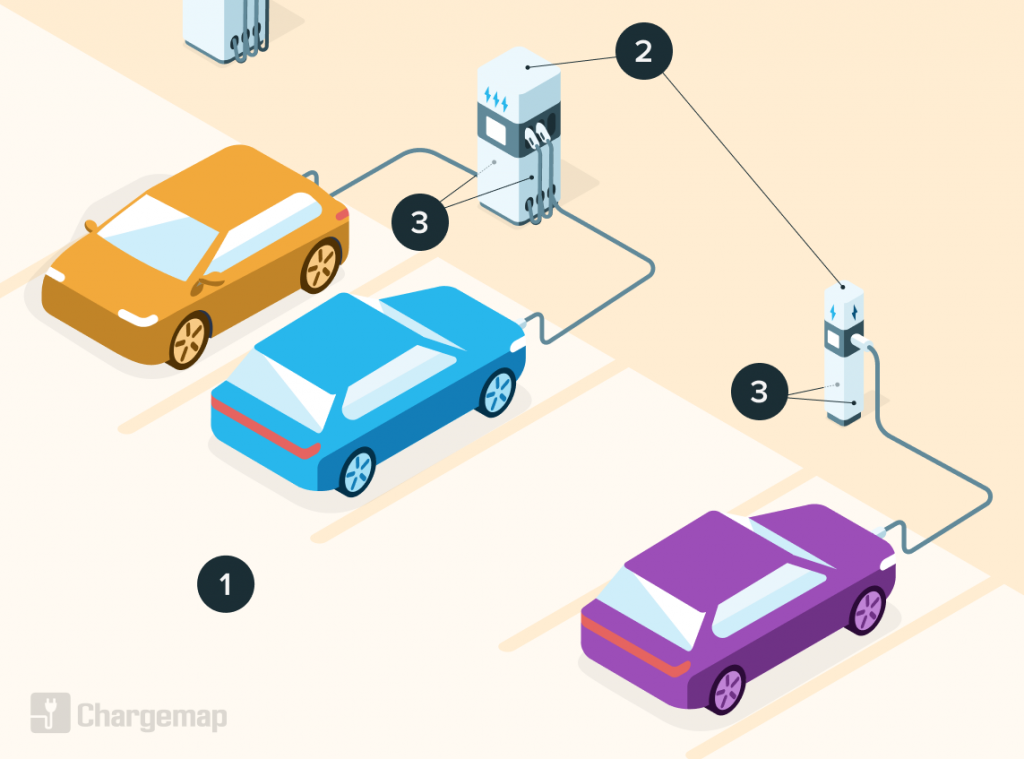Anatomy of a charging pool for electric vehicles
23 October 2020 - 2 minutes to read
Going electric is tantamount to learning a new language or taking a new logic on board. At Chargemap, we’re offering you an overview of the anatomy of a charging pool for electric vehicles. What’s the difference between a charging pool, charging station and charging point? What happens when two vehicles are charging at the same station at the same time?
What exactly is a charging pool for electric vehicles?
If you have just gone electric or are discovering the world of public charging, you need to grasp a few notions about EV charging pools. First of all, let’s get down to the terminology.

- A charging pool for electric vehicles is an area equipped with one or more charging stations.
Examples: a supermarket carpark, a public carpark or a motorway service station, etc. - A charging station is an appliance that’s either fixed to the wall (wallbox) or self-standing. It is connected up to an electrical supply point which can charge one or more vehicles depending on the number of charging points it has.
- A charging point, charge point or EVSE (Electric Vehicle Supply Equipment) connects up one vehicle at a time. A charging point usually has a dedicated parking space.
For example, France boasts around 30,000 charging points open to the general public. In theory, this means that excepting pools that are out of order, the French charging network can charge 30,000 electric vehicles at the same time.
A few pointers
The number of connectors ≠ the number of charging points
While a given charging station may be equipped with several types of connectors and/or cables attached to connectors (for example rapid charging stations), this does not mean there are as many charging points as there are cables. The charging station is fitted with different types of connectors so that it can service the various EV models on the road today.
To put it simply, a charging point, or EVSE, may be fitted with several connectors but can only charge one vehicle at a time.
Example: a charging station has two charging points, each fitted with a domestic connector and a Type-2 connector. There are 4 connectors, but only two vehicles can be connected up to the charging station at the same time.
When in doubt, you can check up the availability of compatible charging points using the Chargemap Pass directly on the Chargemap mobile app.
Same-time connection = less power?
Charging stations often offer two charging points. So when two vehicles are charging at the same time at the same charging station, the charging power available may be shared between the vehicles.
Let’s take a theoretical example:
- A charging station has a power rating of 22 kW in alternating current (AC).
- Two vehicles connect up to it.
- The charging station shares the available power between the two charging points, i.e. 11 kW per vehicle.

However, this is just the theory.
What you need to keep in mind is that if you connect up to a charging station with two charging points, where one vehicle is already plugged in, charging will probably occur at a reduced speed.
For further information, find out about other factors which impact power and charging time for your EV.
Over the past few months, France has recorded unprecedented figures in terms of the number of new electric vehicles on the road. If you have just gone electric, we warmly welcome you into the Chargemap community! We hope that this series of informative articles will help you become a charging guru.
Finally, if you would like Chargemap to broach other subjects in future articles, let us know by making a comment under this article. Happy charging with Chargemap!
And if you still haven’t done it yet,

